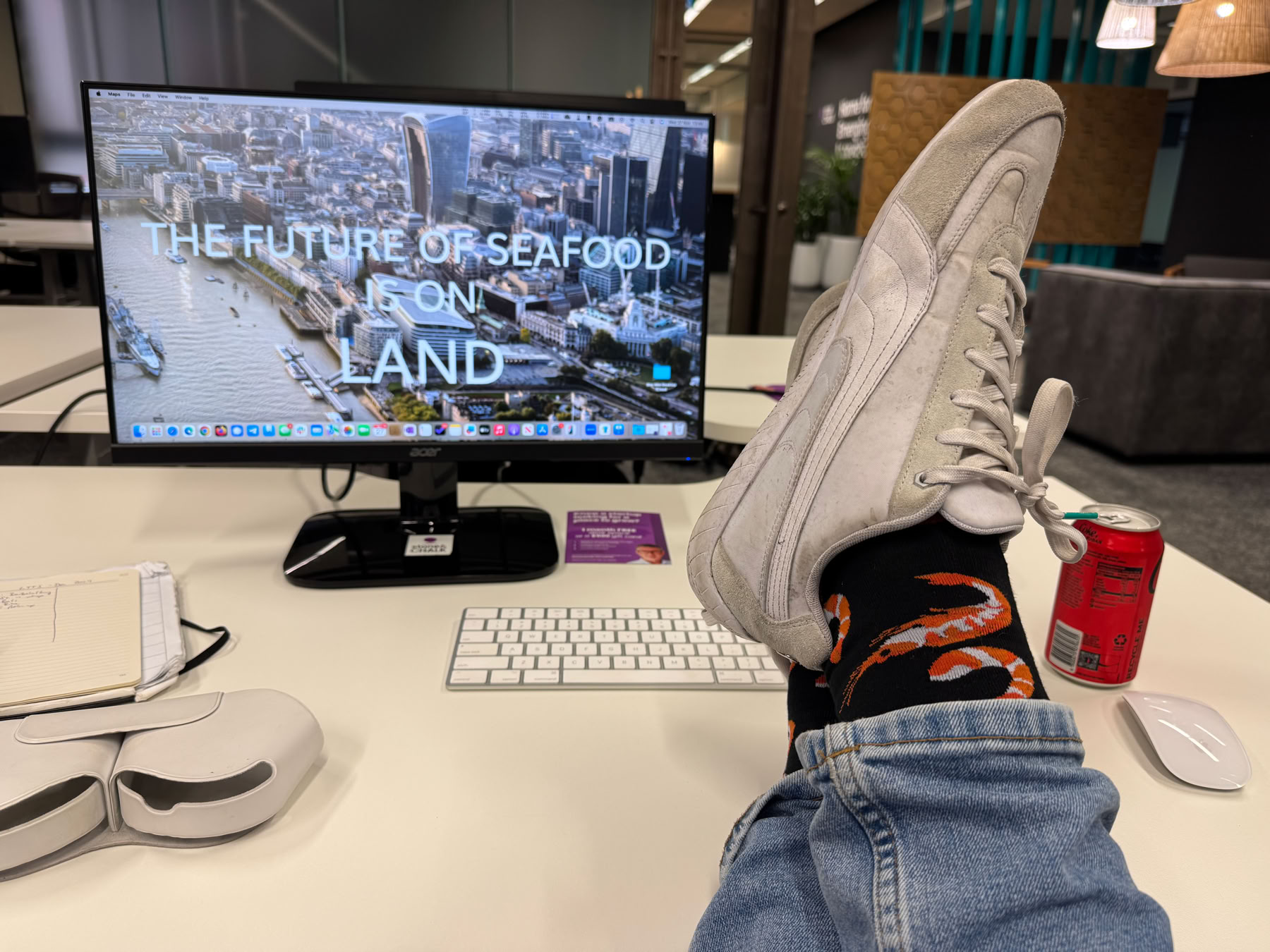07/10/2025
SHR!MP – The Startup Saga
Binge on the complete Season One in one hit! (no time? get the gist in the Episode Guide)
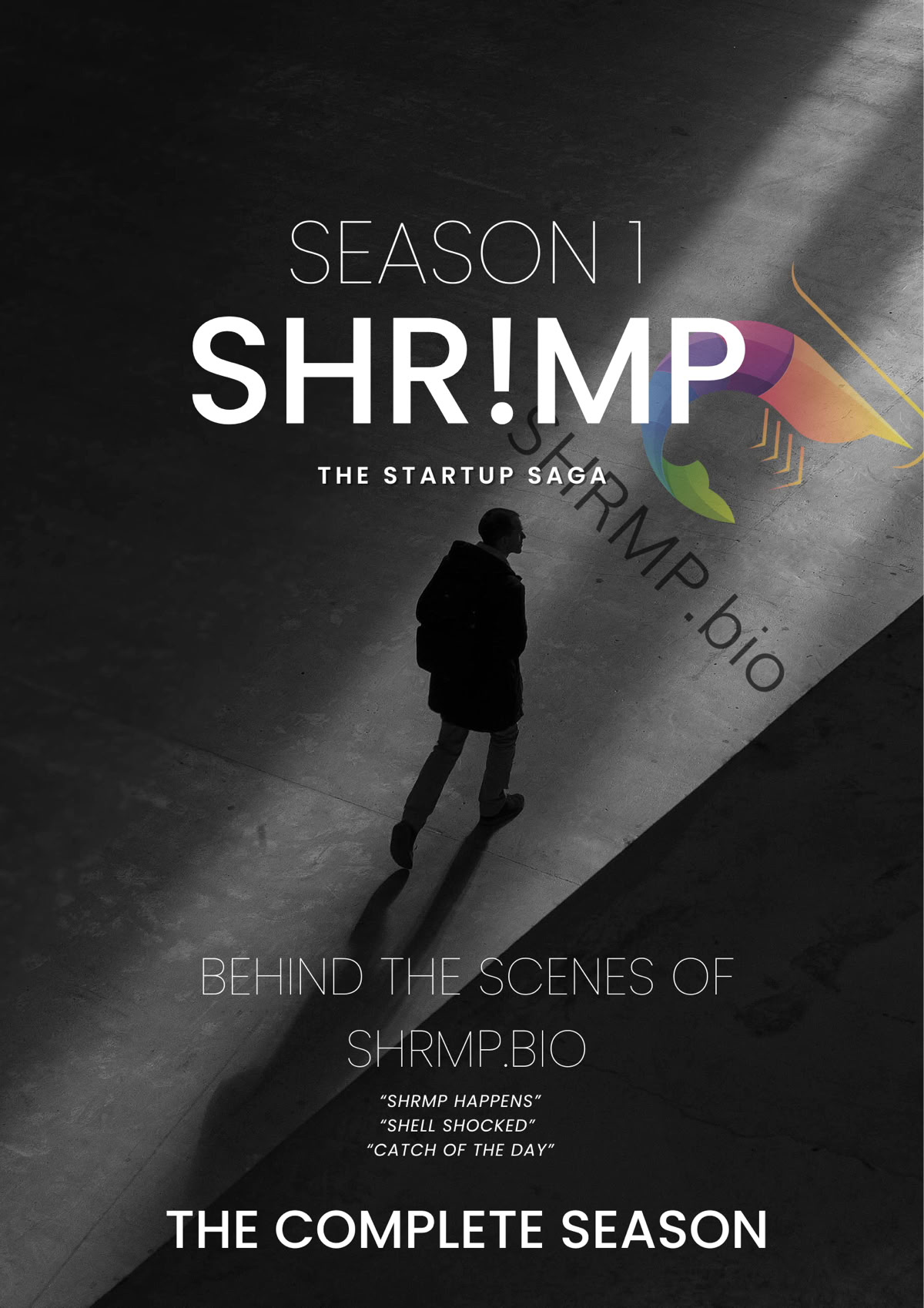
Episode 1: ShrimpoFarm
The final months of my Exopharm journey were a time of reflection. While thinking about our stem-cell production process and some of my exploratory work looking into potentially applying our core Exo technologies to the lab-grown meat.. I mean.. cellular agriculture manufacturing process, I was wondering why one would not "simply" grow cell clusters that are naturally programmed to become the meat we'd like to eat in a similar, automated bioreactor-based system - cell clusters, like small marine animals (see the Genesis of SHRMP.bio). On NYE 2023, I decided 2024 was the year, I wanted to see if it could float as a startup, to develop a next-(next?)-generation food manufacturing system.
The goal for the year: Develop ShrimpoFarm from an idea into a development plan and introduce it to the Australian innovation ecosystem, find a team and some money and get building the Future of Seafood Manufacturing.
But how to get started?
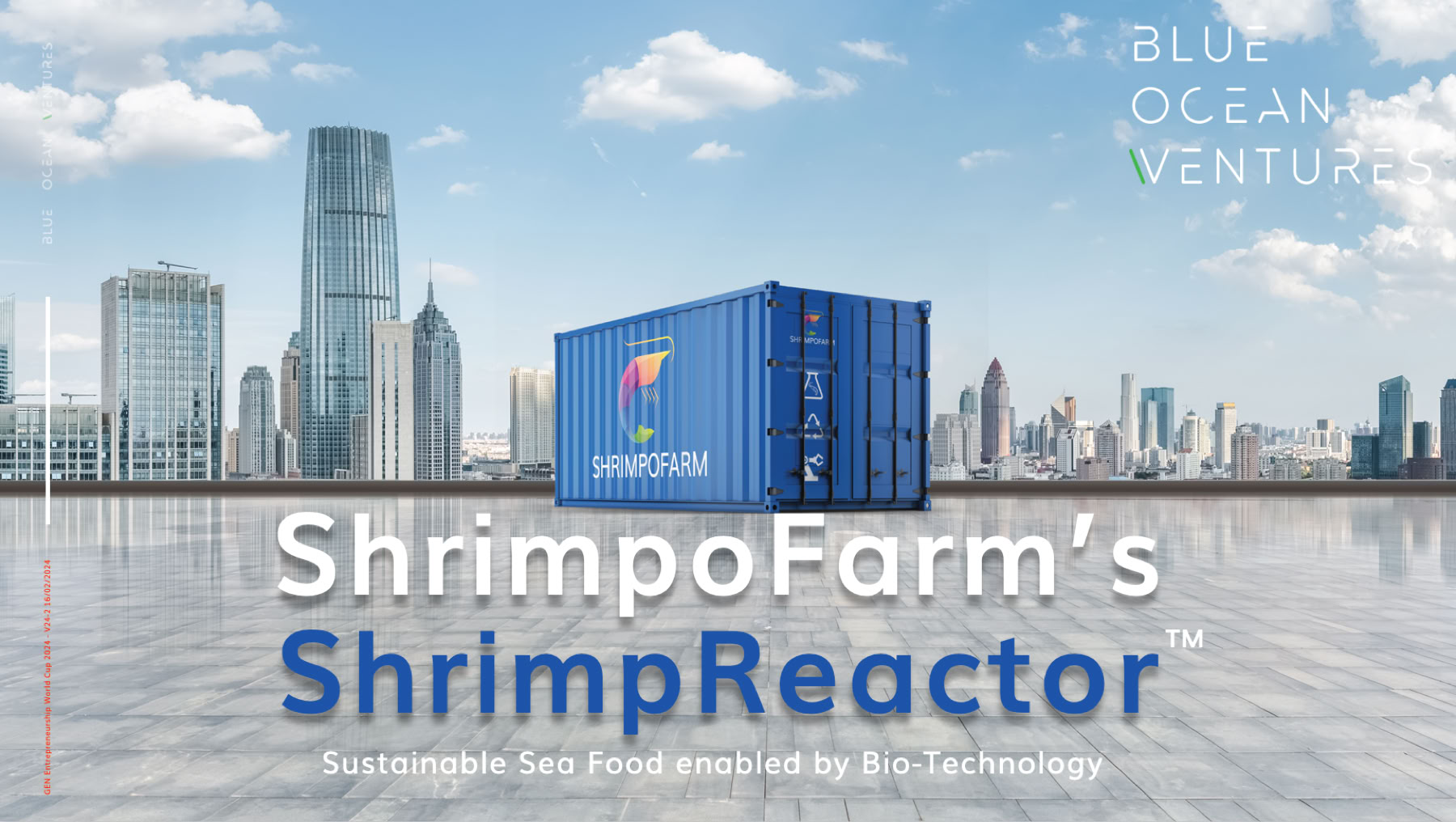
Episode 2: Just Launch, Mate.
As a first step, I applied to a startup competition - and nothing less than the Entrepreneurship World Cup would do.
A deadline to pitch is my best motivator to get started and work on putting an idea on paper.
A real project/company name was also required. Days went by, pondering and wasting endless hours on playing through options of potential creative company names (like Desert Shrimp, Shrimpbot, Space Shrimp, Ocean Reactor, Blue Farmer, Deep Current, Tidal Gen Bio Harvest, Deep Sea Foods and other great ideas...).
Ultimately, I gave up and decided just to call it what it is: shrimp - at least for starters. At least everyone will understand what it's about.
Surprisingly, shrimp.com.au was still available for sale (at around $9999). While this looked like a great investment opportunity, it seemed wiser to stick to the startup playbook.
Who needs the "i" anyway - ShrimpoFarm is a high-tech biotech company, and vowels are so 2020. SHRMP.bio was born for about $99. And innovative SHRMP.bio(tech) is what we aim to do.
As the second step, I joined Startmate's Launchclub.
Launchclub definitely helped provide some structure around the initial steps - it was tough at times to find the motivation and focus to do it "alone." In the first months, SHRMP.bio took shape at home, at Startmate's office, at yacht clubs (providing a workspace away from home!), cafés, airports, and hotels – having the weekly Startmate check-ins with a virtual and occasionally real team proved really helpful.
I met really interesting people and learned something new every day across a broad range of business and technology fields. In short, it was great fun.
But how long would the fun go for?
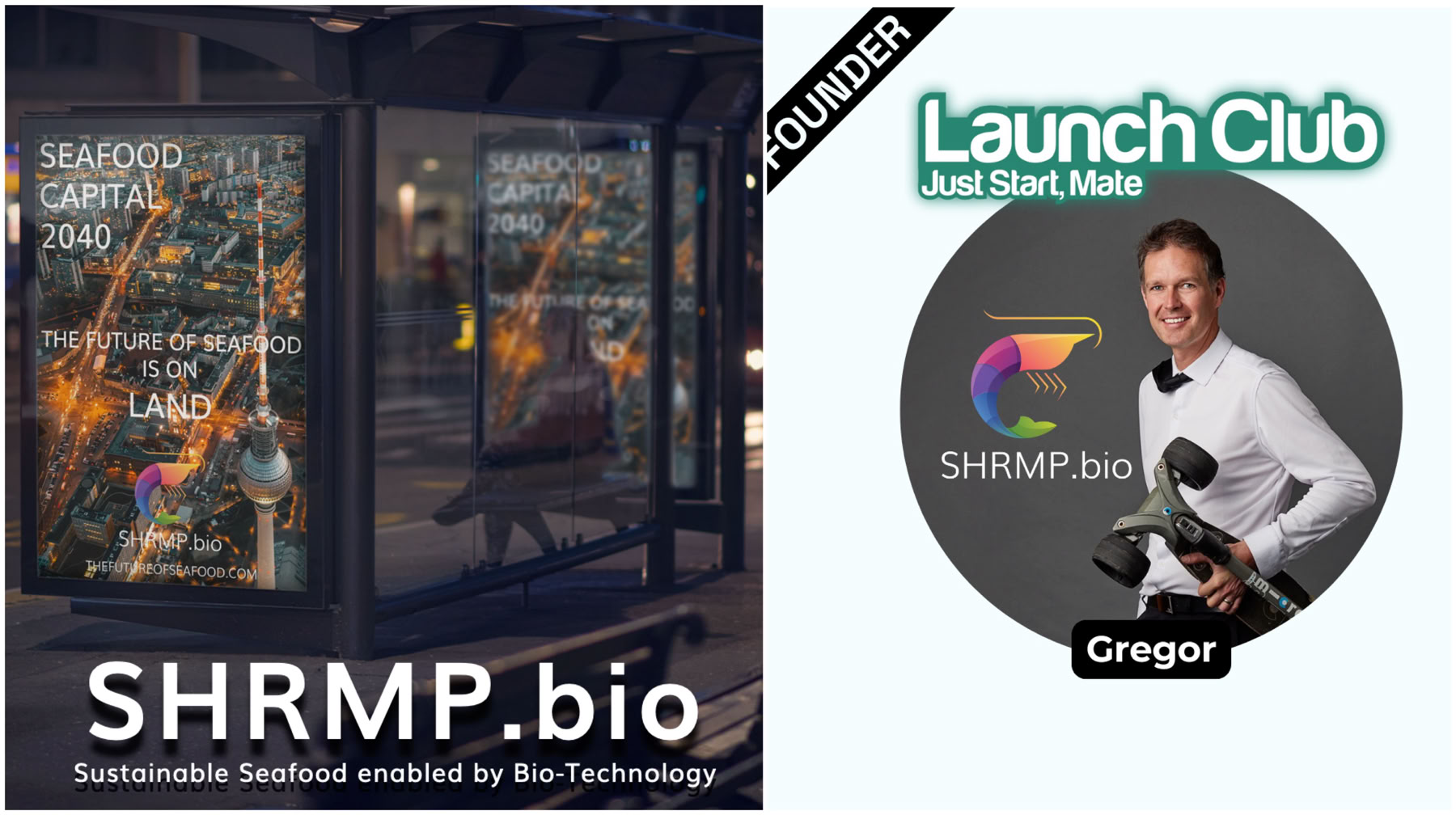
Episode 3: Beat Queensland
Alongside the Entrepreneurship World Cup, the deadline for a LaunchVic Grant application arrived. Well, Go Big or Go Extinct was my motto for the World Cup, and the pitch served as the basis for the grant application. Being based in Victoria and working to launch one of the coolest projects this state has seen in this sector (probably ever), which other organisation would be better suited to support SHRMP's vision and ambition than the state's own innovation funder, that even has “Launch” in its name? And surely nothing would convince a Victorian organisation more than a chance to beat Queensland in one of their key industries.
The SHRMPcruiser was born - as an illustration for the power of scale that a vertical, modular aquaculture approach could deliver.
The Entrepreneurship World Cup judging panel was impressed - at least enough for SHRMP to get into the Australian final. LaunchVic was not impressed. Or if they were, there's probably not much "Launching" left in them - "The idea has merit, but the stage is too early" as the inclusion criteria for funding had moved to "having a working prototype and/or sales" or some other later stage cut-off over time.
Maybe we will try beating Queensland another time.
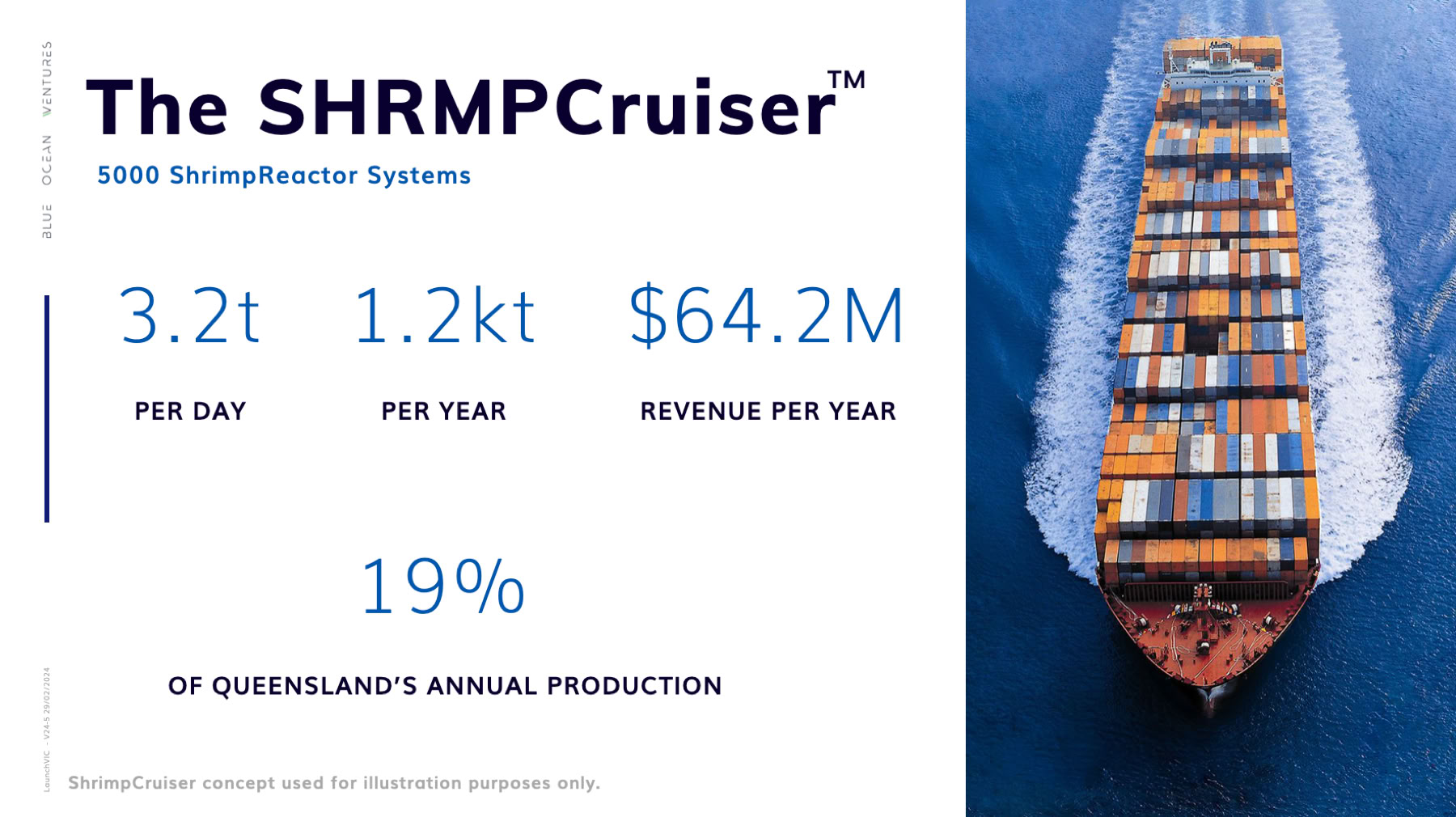
“If anyone from the Victorian Government is listening… With just 6 Cruisers, parked right here in Geelong. we could beat Queensland in one of its core industries!”
Episode 4: (Another) Hopeful Fool
The initial months revealed some interesting challenges. As I ventured into a (for me) new field, I also uncovered some unexpected “unknown unknowns” or simply incorrect assumptions.
AgTech is a genuine Australian future industry and growth opportunity (yes, it is)… but aquaculture is not (although it could be).
Australians love seafood. Australia has a longer coastline than the US. It manages a larger surface area over water than over land, but seafood is the only food category in which we are a net importer. In almost every other agricultural product, we export many times what we consume ourselves. The main consequence for SHRMP is that there is no significant local industry, and without such an industry, there’s little interest in innovation in this sector— and therefore no funding. Also, cheap Asian-import shrimp is... cheap. Too cheap for locally produced or caught options.
I also had a serendipitous and fantastic meeting with a real veteran of the local industry. Long retired, he had great words of encouragement, but also the experience of having seen it all before. Flashback to the 1970s (or so): Onshore aquaculture is gaining hype for the first time as a technological breakthrough for seafood manufacturing in Australia. Many companies spring up, generating a lot of excitement, but it was all followed by a rude awakening. Every single one fails - except for one: MainStream (which apparently had a very tough time getting to where it is today). “Gregor, you have to know how to farm first before you can think about bringing any new technology in.”
The most concerning insight to me, however, as I try to lay the foundations for a future technology company and work in Australia's innovation sector, is the surprisingly high prevalence of short-term thinking I come across. Most people I spoke to seemed unaware or unconcerned about where we're heading in what I think is not too distant a future (after all I can still remember Y2K very clearly). And if it doesn't turn a profit in two years, there's very little interest in it—at least from those I'd talked to during this time.
Could I be on the wrong track entirely?
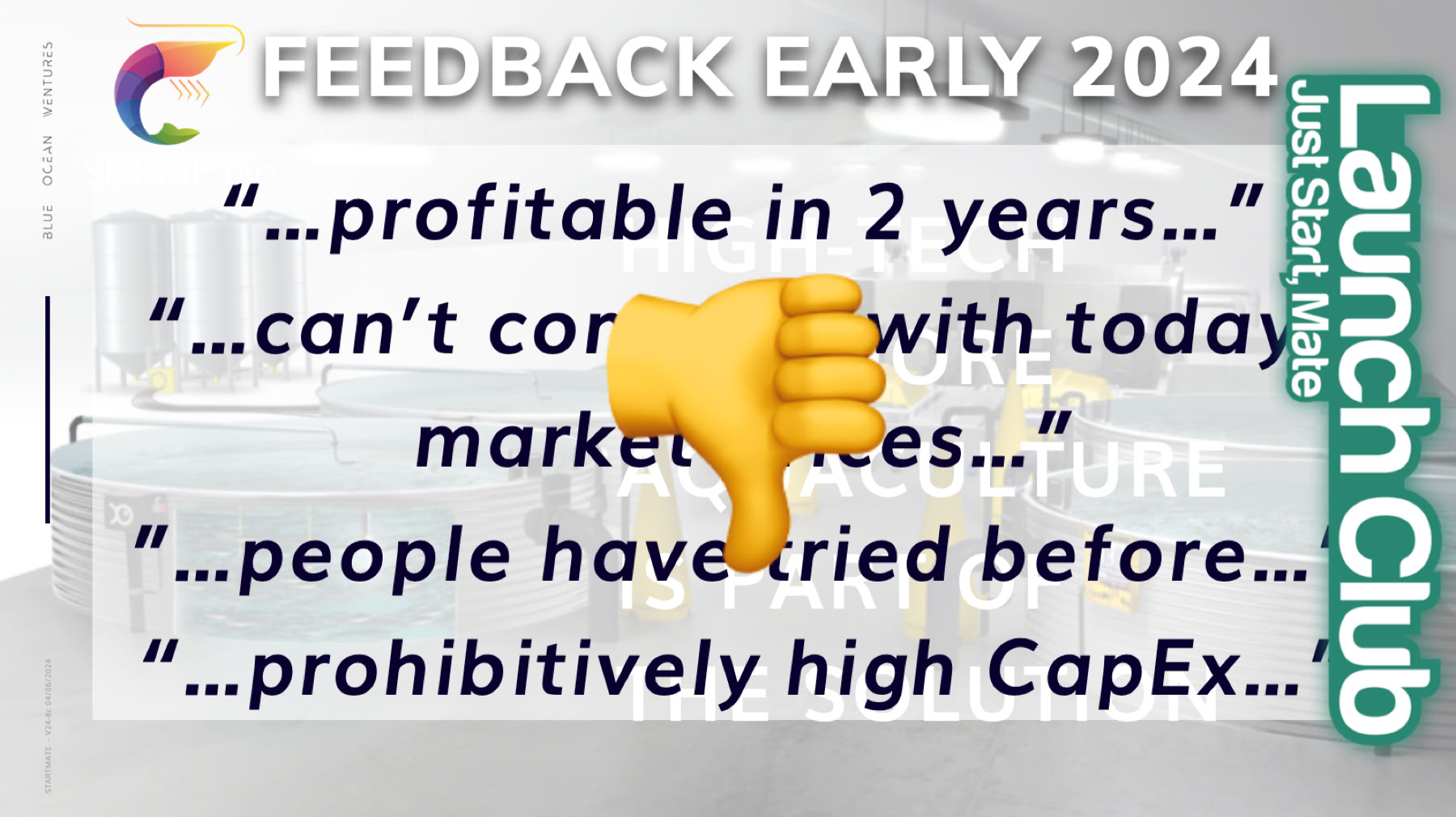
Episode 5: AquaFarm(ing)
Doubting my initial assumptions and the overall greatness of my idea, it was not the time to give up (yet).
I chose to ignore today's market prices and concerns about cheap imports because they will likely change by the time SHRMP.bio is ready. If cheap imports are still around then, they will be produced using SHRMP.bio's technology.
Not knowing about aquaculture… Well, in analogy to cell culture, I had considered “the growing animals part” merely an engineering project (of the future), rather than a farming problem. Still, it's a valid concern; it would not hurt to know a bit more about aquaculture myself: I hammer through a training course and I now hold a Certificate of Completion "Introduction to Recirculating Aquaculture Systems". That was more interesting and useful than I had initially thought, and it affirms my "future engineering project" view.
I am most concerned, however, about the possibility that I am misjudging the commercial opportunity behind aquaculture, and I concede that "gut feeling" may not be a sufficiently strong basis to convince a potential investor (including myself). Recently equipped with the necessary skills from my Berkeley Executive Education programme, I decided to invest considerable effort in developing future scenarios myself to test whether there may indeed be a need for a solution like SHRMP.bio in the future and/or an opportunity for aquaculture in general. This work became the "Future of Aquaculture" presentation I gave at the AquaFarm conference (although I had intended to present SHRMP.bio initially).
And it exceeded my original assumptions - aquaculture could, in fact, be a very significant future opportunity.
My main conclusion at this point: the worst thing to do would be not to do anything in this area.
Mid-year now, Launchclub is coming to an end, and with it, the first phase of SHRMP.bio.
The early months do end on a high note with a small win, a real win: I pitched SHRMP.bio at the final Launchclub pitch competition (audience choice award!) and secured access to Stone&Chalk's co-working space later in the year (as part of Startmate's Buildmate Programme Pilot).
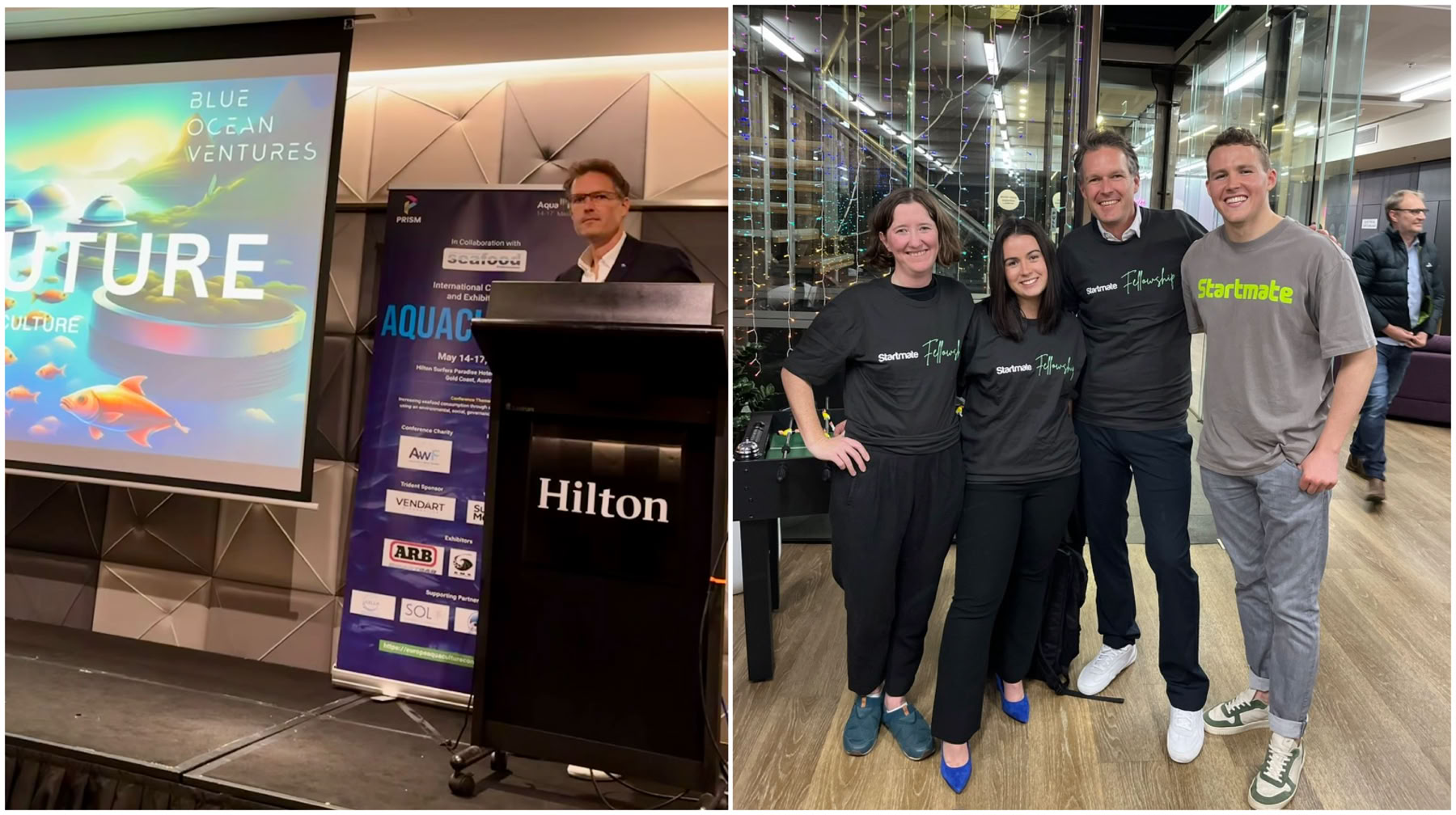
Episode 6: Unsung Heroes
To avoid losing the initial momentum SHRMP had until Buildmate started, I was looking for a way to sustain it. Through my early involvement with NAFI, I met our first potential intern, whom I was eager to provide with a worthwhile opportunity. From previous experience, I knew that hosting one intern typically required about the same overhead as hosting several, which would likely create a more rewarding environment for him. Based on this idea, I advertised SHRMP.bio's first Startup Internship Programme (SIP)on LinkedIn, which received over 75 applications in two days from across the globe before LinkedIn shut the ad down for some obscure reason. After a week of interviews, SHRMP.bio's first team was formed: six fantastic volunteers from three different Australian states and three different countries began an early startup journey to flesh out ideas and outline what a first prototype of the SHRMPreactor might look like.
In our second meeting, the team announced, "If there's not going to be a real shrimp in the system, we are not going to work on the project".
What can you do? Let's start planning for a live system, then (sounded unnecessarily complicating things to me, but at the same time also a lot more fun as well).
And quite possibly, that early SHRMP team isn't even aware of the lasting impact they've had on SHRMP.bio; their drive pushed SHRMP to develop the first prototype ideas into an actionable plan by the time we moved into Stone&Chalk for the latter half of 2024, when we finally joined Startmate's Buildmate pilot programme.
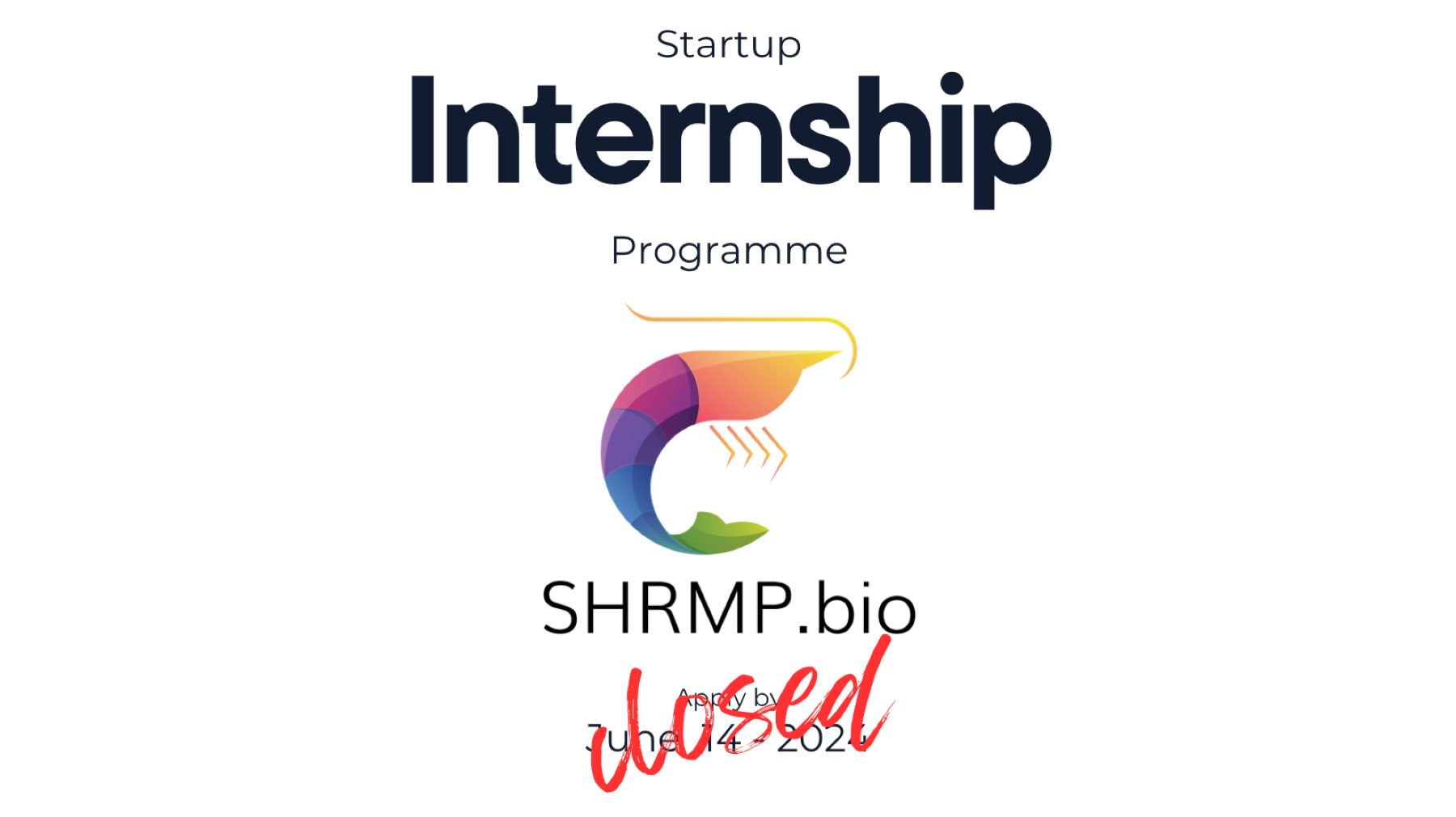
Episode 7: Just Build, Mate. (just don't build a hardware Reactor!)
For the second half of the year, SHRMP and I moved into Stone&Chalk, enjoying the laurels of pitching by having a nice Melbourne CBD-based office and some really good company as part of Startmate's Buildmate programme.
Some members of the Internship team also stayed on a bit longer as we worked on building out the prototype plans and the development plan for the first year of operations.
Early Q4, the plans for the first prototype were finished; however, here we seemed to push the limits of the “Build” in Buildmate, as there was not much enthusiasm for us to actually put a tank into at least the basement of the building to truly put “the build” into SHRMP.bio.
So, while the plans were ready, “just” a few minor parts were missing for action: a place that would be suitable to build it, some money and ideally a small team to build it with…
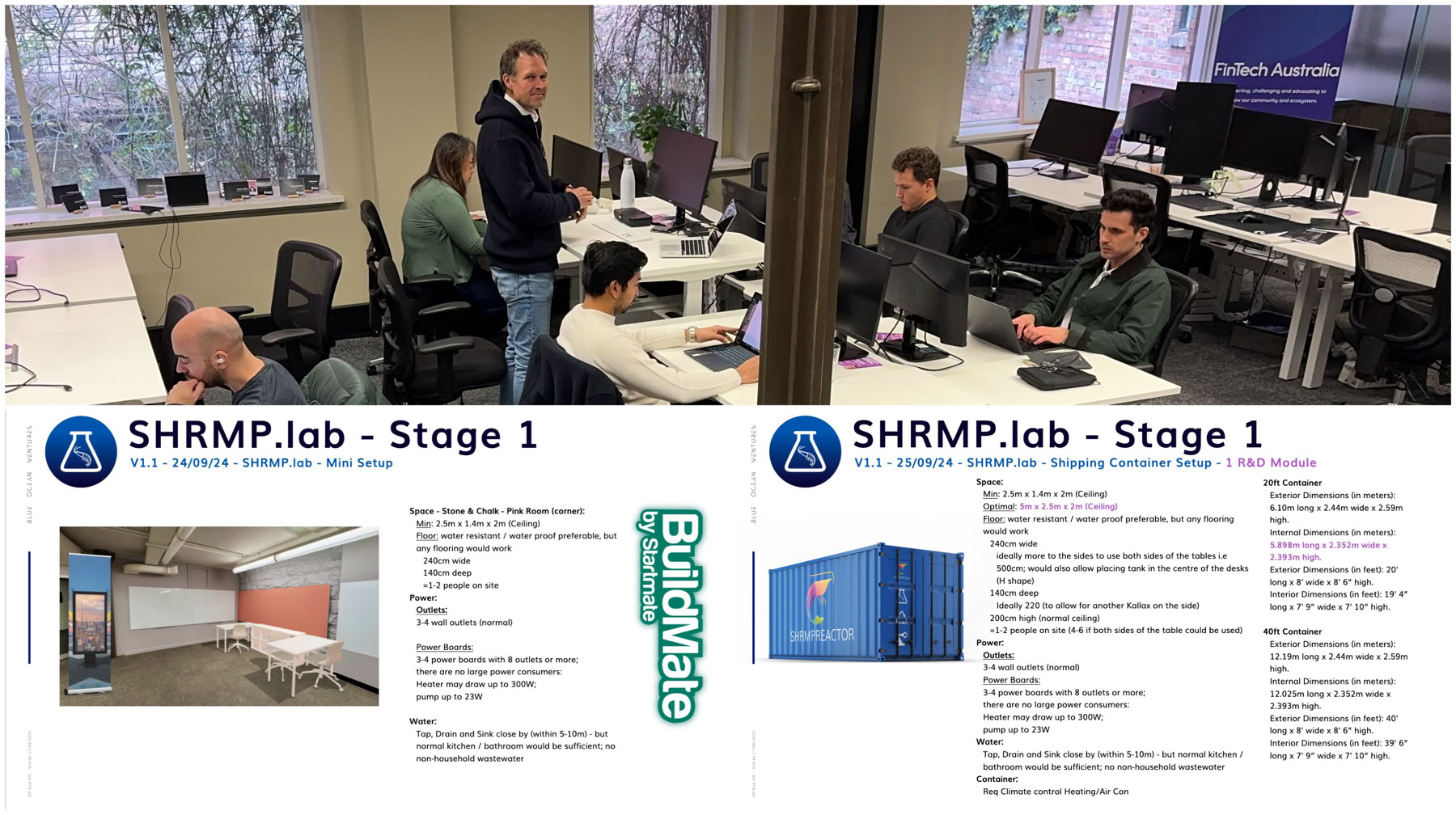
The Buildmate (MEL) crew hard at building. The first plan for the SHRMPlab would have fitted nicely into the basement (mocked-up with the IKEA AR App) - and - of course totally planned - it could also prefectly fit a 20ft Shipping Container…
Episode 8: Finding SHRMPy
For the rest of 2024, in the absence of lab, team, and funding, I decided to focus on finding at least one of the three. And so the final weeks of 2024 were dedicated to speaking with as many people as possible, everyone who might have at least a remote interest in aquaculture, sustainable seafood, future nutrition, cool technology, AgTech, FoodTech, or Biotech. No single pitch competition was missed, applications submitted to bascially all remaining opportunities. Both SHRMP's website and LinkedIn page saw significant effort put in, especially to highlight why we believe there is a potentially massive future opportunity in developing high-tech on-shore aquaculture approaches.
A few trips to Sydney, numerous online meetings, and, while we were at it, a submission to the Startmate accelerator.
During this phase we also had a new team member join: SHRMPy, who started to add some fun and cheekiness into SHRMP and beyond – not only to provide some entertainment, but also to counter the otherwise rather bleak future trends that, yes, make on-shore aquaculture commercially really interesting, but are overall a rather sad outlook for all of us.
But could SHRMPy deliver?

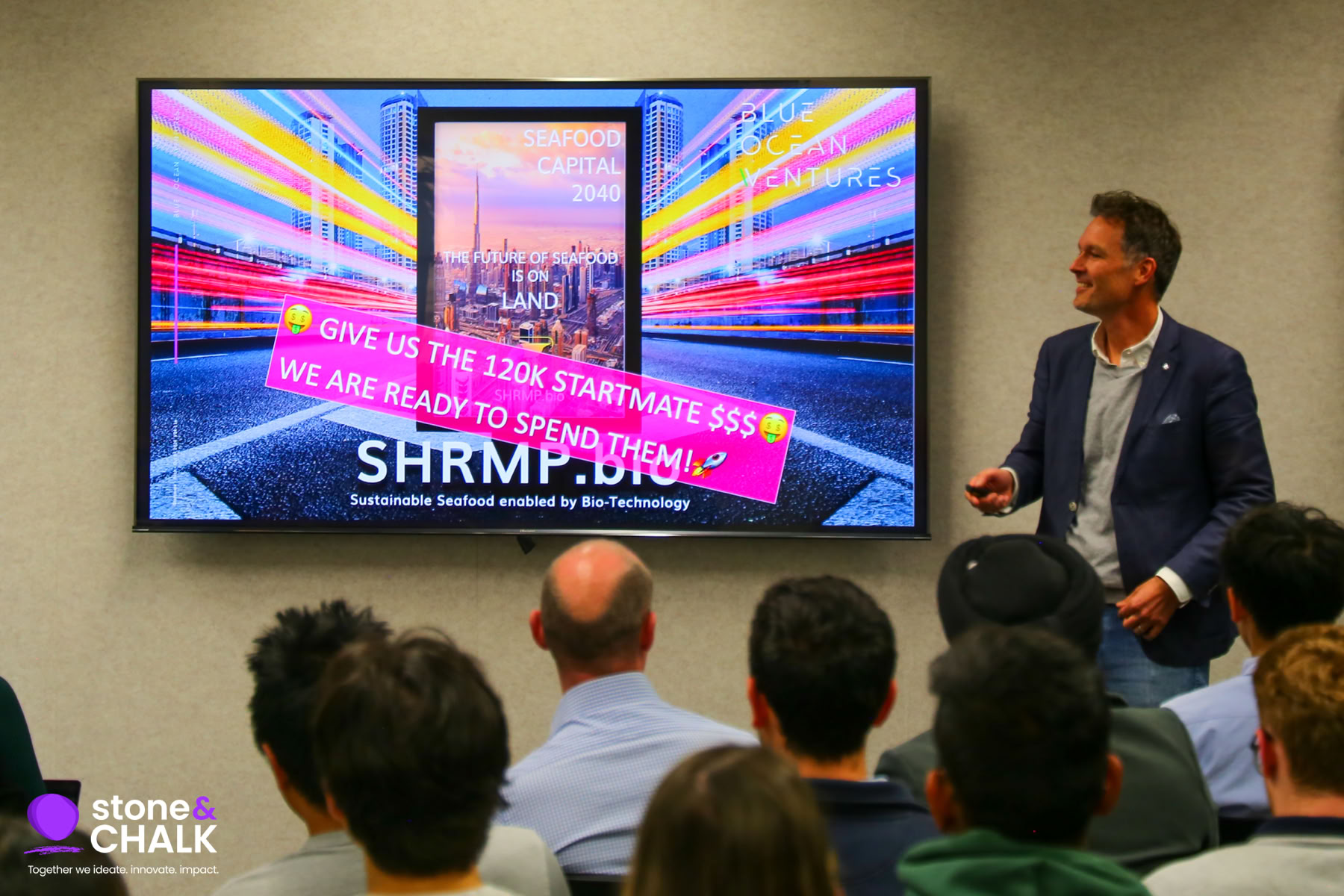
Episode 9: 300 (Prepare for Glory)
With the year 2024 drawing to an end, Startmate ended its Buildmate pilot, and SHRMP.bio lost its city office again – SHRMPy was back on the street. However, without Buildmate, SHRMP.bio probably wouldn't have existed in 2025. Having this opportunity and the team that came together at least once a week helped us immensely to get through the next stage.
By the time Christmas comes around, SHRMP.bio had developed into a (very loose and globally dispersed) team of three, had a full prototype development plan ready to execute, spent considerable effort on publishing content, gained its first fan from the investment community (who provided valuable feedback and some good ideas), but still had no physical space to work in, no dedicated onsite team. And a whopping $300 left in the bank.
Not the greatest starting point for 2025…
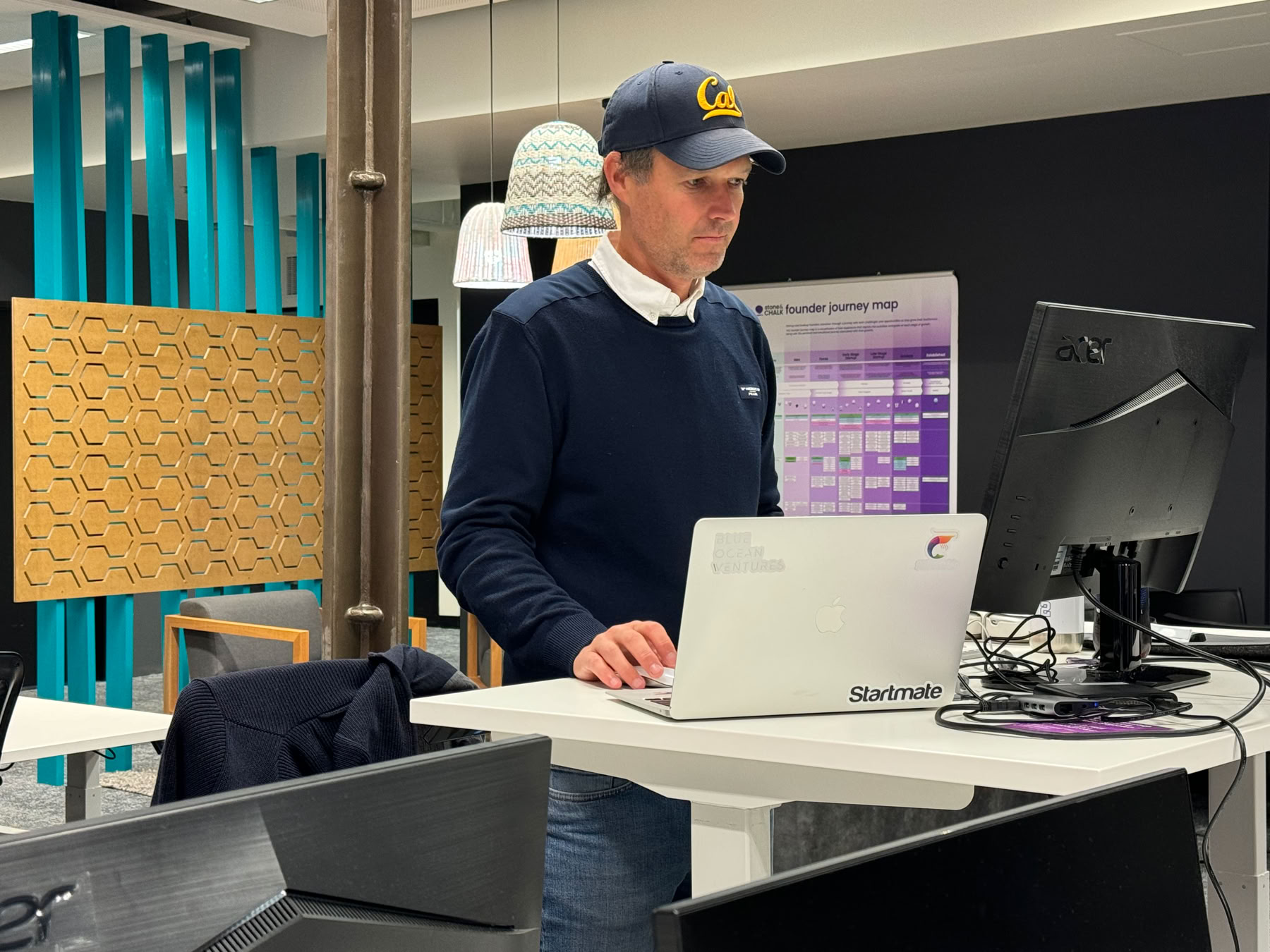
Episode 10: Cockroaches-by-the-Sea (Season Finale)
In our end-of-2024 review, we looked at what worked and what didn't.
The SHRMP.bio story worked in some ways:
Everyone easily understood it (the straightforward company name also helped); it inspired audiences based on the sustainability angle alone. Support could be recruited from all over the world, and volunteers had spent some time on it – for free!
But the story suffered from being early, requiring a long (too long for most) development horizon and possibly had a vision that is (way) "too big" or "too science fiction" for many in Australia.
In addition, we were learning the hard way that, overall, aquaculture is de-facto a non-existent industry in Australia and generally that seafood is also severely economically challenged at the moment, and that globally.
Ironically, part of this is the reason why we think the SHRMP.bio vision has so much potential as a Future Industry for Australia.
What absolutely did not work in a meaningful way was LinkedIn, with the only exception being for recruitment purposes - and well, a surprising number of people started calling me SHRMPy when I met them in real life! So, maybe SHRMPy worked, too.
A consulting firm invited me to a workshop around that time, a very enjoyable and insightful event. Overlooking the city from the high-rise meeting room, a glass of Champagne in hand, the view of the setting sun made it a festive occasion, but also offered a reflective moment, thinking about the year that nearly was.
A workshop speaker from the firm dropped by, and we had a nice chat. He asked if I had any concerns about animal welfare or the potential perception of people concerned with animal rights. It had not been of big concern to me so far at all. In fact, the choice of shrimps as the organism was part of the reason why I was neither personally concerned too much nor about the perceptions of others: “They are basically cockroaches of the sea” I answered, suggesting their land-based brethren didn’t generally elicit much love.
“Hmm.. well, should you ever have to, you can just call your company Cockroaches-by-the-Sea”.
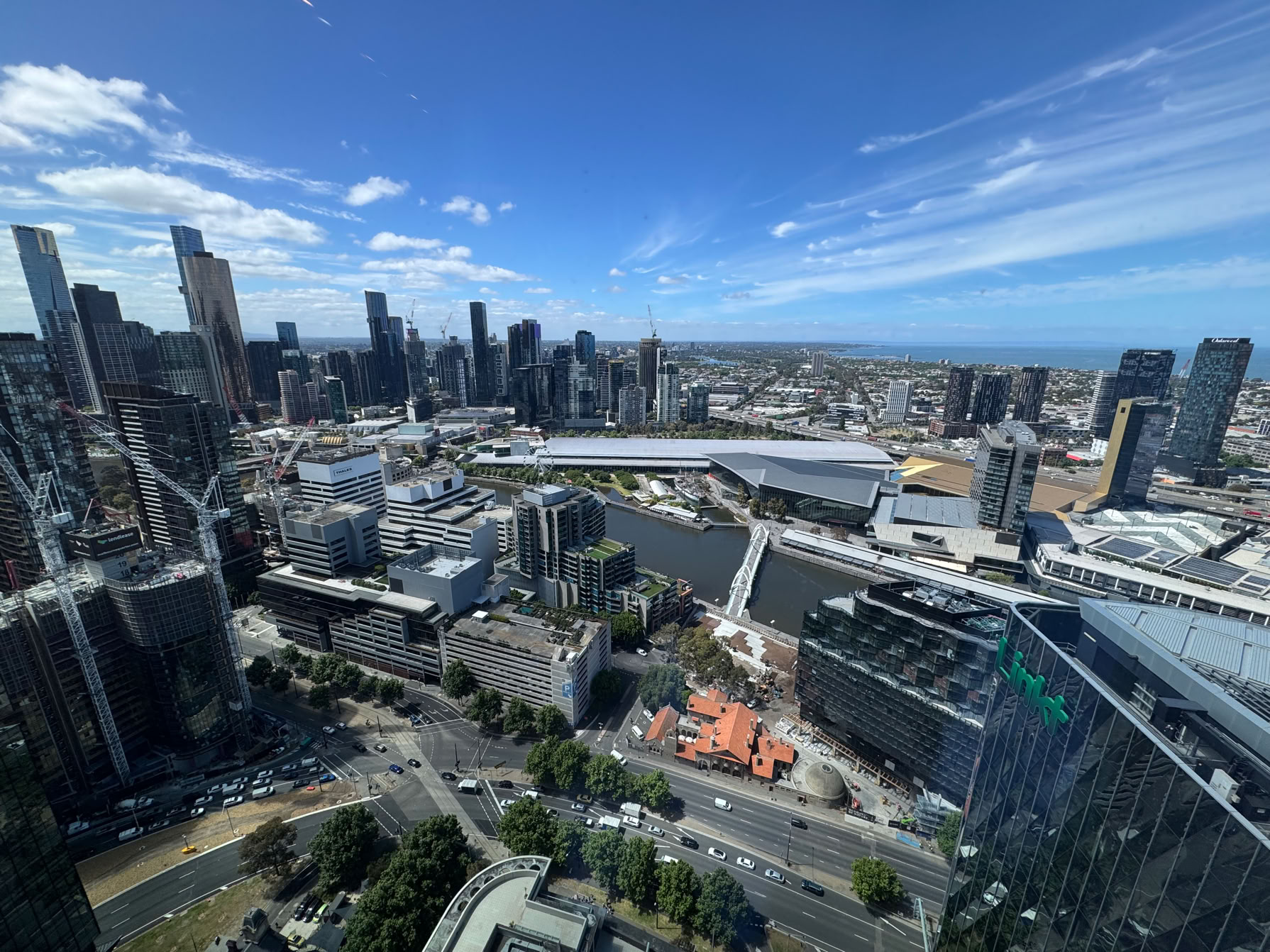
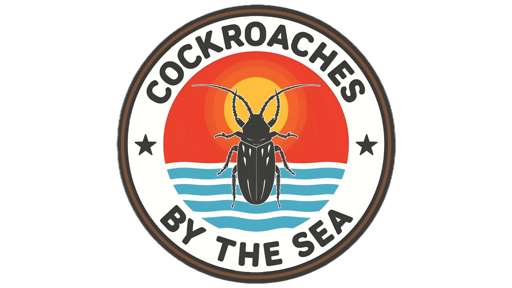
Season 2 – Teaser: Oh Captain! My Captain! (S02E01 Teaser)
Reviewing the website and LinkedIn metrics at the end of the year was a rather disheartening exercise. Admittedly we had not invested much in a professional marketing campaign, nor employed any marketing specialist, but instead I had spent a fair amount of time testing diverse messages and content, sometimes even half-heartedly (as I had “more important” things to do). Overall, the main intention was modest to begin with: to put some of our work out in the open, so it could at least be found if someone were looking for it.
What had worked a million times better were real-world, face-to-face meetings or emails targeting specific people for specific reasons. Both of which I also enjoy a lot more.
Yet, even those had not yielded any meaningful outcome towards securing the future of SHRMP.bio.
Except for one post. That post had magnitudes higher traction than any of the others. And that single datapoint should define everything we did in 2025….
